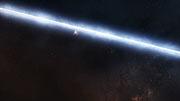Lehdistötiedote
Planeetanmuodostus meneillään?
Tähtitieteilijät ovat saattaneet havaita ensimmäisen nuorta tähteä ympäröivää syntymäkiekkoa raivaavan kohteen
24. helmikuuta 2011
Kansainvälinen tähtitieteilijäryhmä on onnistunut tutkimaan nuorta tähteä ympäröivää lyhytaikaista materiakiekkoa planeettajärjestelmän muodostuksen alkuvaiheissa ESO:n VLT-teleskooppia käyttäen. Ensimmäistä kertaa on havaittu tähden pieni kumppani, joka saattaa olla syynä kiekossa olevaan leveään aukkoon. Tulevat havainnot vahvistavat onko tämä kumppani planeetta vai ruskea kääpiötähti.
Planeetat muodostuvat nuoria tähtiä ympäröivän kiekon materiaalista, mutta siirtymä pölykiekosta planeettajärjestelmään on nopea ja vain harvat kohteet havaitaan tämän vaiheen aikana [1]. Yksi tällainen kohde on T Chamaeleontis (T Cha), himmeä tähti eteläisen taivaan Kameleontin tähtikuviossa. Se on Auringon kaltainen, mutta aivan elämänsä alussa [2]. T Cha on noin 330 valovuoden etäisyydellä Maasta ja vain noin seitsemän miljoonan vuoden ikäinen. Tähän mennessä näissä siirtymävaiheen kiekoissa ei ole havaittu planeettoja, joskin planeettoja on nähty aiemmin vanhemmissa kiekoissa (eso0842, heic0821).
"Aikaisemmat tutkimukset ovat osoittaneet, että T Cha on erinomainen kohde planeettajärjestelmien muodostumisen tutkimiseen," huomauttaa Johan Olofsson (Max-Planck-Institut für Astronomie, Heidelberg, Saksa), yksi uutta tutkimusta käsittelevien Astronomy & Astrophysics -julkaisusarjassa ilmestyneiden kahden artikkelin pääkirjoittajista. "Mutta tämä tähti on varsin etäinen ja koko VLTI:n (VLT-teleskoopin interferometri) teho tarvittiin hyvin pienten yksityiskohtien erottamiseen ja sen näkemiseen mitä pölykiekossa tapahtuu."
Tähtitieteilijät havaitsivat T Cha -tähteä ensin käyttäen AMBER-havaintolaitetta ja VLTI:tä [3]. He huomasivat, että osa kiekon materiaalista muodosti kapean pölyrenkaan vain noin 20 miljoonan kilometrin etäisyydellä tähdestä. Tämän sisemmän kiekon ulkopuolelta he löysivät pölystä vapaan alueen ja ulomman kiekon, joka ulottui tähdestä ulospäin alkaen 1.1 miljardin kilometrin etäisyydeltä.
Nuria Huélamo (Centro de Astrobiologia, ESAC, Espanja), toisen artikkelin pääkirjoittaja jatkaa kertomusta: "Meille aukko T Cha:n pölykiekossa oli pitävä todiste ja kysyimme itseltämme: saattaisimmeko todistaa aukkoa raivaavaa kumppania tähden protoplanetaarisessa kiekossa?"
Himmeän kumppanin löytäminen noin läheltä kirkasta tähteä on kuitenkin valtaisa haaste ja tutkimusryhmän täytyi käyttää VLT:n NACO-havaintolaitetta uudella ja tehokkaalla tavalla, jota kutsutaan harvaksi apertuurimaskaukseksi, saavuttaakseen tavoitteensa [4]. Tarkan analyysin jälkeen he löysivät selvän jäljen pölykiekon aukossa olevasta kappaleesta, noin miljardin kilometrin etäisyydellä tähdestä - hieman kauempana kuin Jupiter on Auringosta - ja lähellä aukon ulkoreunaa. Tämä on ensimmäinen havainto tähteä paljon pienemmästä kohteesta tähden planeettoja muodostavan pölykiekon aukossa. Todisteet viittaavat siihen, että kumppani ei voi olla normaali tähti [5], mutta se voi olla joko pölyn peittämä ruskea kääpiötähti [6] tai, mikä on vielä jännittävämpää, hiljattain muodostunut planeetta.
Huélamo sanoo lopuksi: "Tämä on merkittävä tutkimus, joka yhdistää kaksi erilaista ESO:n Paranalin observatorion huippuhavaintolaitetta. Tulevat havainnot auttavat meitä saamaan enemmän selville kumppanista ja kiekosta sekä ymmärtämään mikä ruokkii sisempää pölykiekkoa."
Lisähuomiot
[1] Siirtymävaiheen kiekot voidaan havaita koska niistä lähtee vähemmän säteilyä keskipitkillä infrapuna-aallonpituuksilla. Puuttuva säteily voi selittyä pölykiekkoon muodostuvilla aukoilla ja pölyn kaikkoamisella tähden läheltä. Hiljattain muodostuneet planeetat ovat voineet synnyttää nämä aukot, joskin myös muita vaihtoehtoja on olemassa.
[2] T Cha on T Tauri -tähti, hyvin nuori tähti, joka yhä supistuu kohti pääsarjaa.
[3] Tähtitieteilijät käyttivät AMBER-havaintolaitetta (Astronomical Multi-BEam comnineR) ja VLTI:tä yhdistääkseen valon kaikista neljästä 8.2-metrisestä VLT-teleskoopin yksiköstä luoden täten halkaisijaltaan 130-metrisen "virtuaaliteleskoopin".
[4] NACO (tai kokonaisuudessaan NAOS-CONICA) on ESO:n VLT-teleskooppiin kiinnitetty adaptiivisen optiikan havaintolaite. Kiitos adaptiivisen optiikan tähtitieteilijät voivat poistaa suurimman osan ilmakehän aiheuttamasta sumentavasta vaikutuksesta ja siten saada erittäin teräviä kuvia. Tutkimusryhmä käytti NACOa uudella tavalla, jota kutsutaan harvaksi apertuurimaskaukseksi, etsiäkseen tähden kumppania. Tämä on tietyntyyppistä interferometriaa, jossa ei yhdistetä useasta teleskoopista tulevaa valoa, kuten VLTI:ssä, vaan käytetään yhden teleskoopin peilin eri osia (tässä tapauksessa VLT:n yksikköteleskooppi 4:n peiliä). Tämä uusi tekniikka on erityisen hyvä etsittäessä himmeitä kohteita hyvin lähellä kirkasta kohdetta. VLTI/AMBER on parempi tutkittaessa sisemmän kiekon rakennetta ja vähemmän herkkä kaukaisen kumppanin vaikutukselle.
[5] Tähtitieteilijät etsivät tähden kumppania käyttäen NACO:a kahdella eri spektrialueella - noin 2.2 mikrometrin ja 3.8 mikrometrin alueilla. Kumppani näkyy vain pitemmillä aallonpituuksilla, joten kohde on joko viileä, kuten planeetta, tai pölyn peittämä ruskea kääpiötähti.
[6] Ruskeat kääpiöt ovat kohteita, joiden koko on tähden ja planeetan väliltä. Ne eivät ole tarpeeksi massiivisia fuusioidakseen vetyä ytimissään, mutta ovat suurempia kuin Jupiterin kaltaiset jättiläisplaneetat.
Lisätietoa
Tämä tutkimus esiteltiin kahdessa tieteellisessä julkaisussa: Olofsson et al. 2011, "Warm dust resolved in the cold disk around TCha with VLTI/AMBER", ja Huélamo et al. 2011, "A companion candidate in the gap of the T Cha transitional disk", jotka ilmestyvät julkaisusarjassa Astronomy & Astrophysics.
Tutkimusryhmään kuuluvat J. Olofsson (Max-Planck-Institut für Astronomie [MPIA], Heidelberg, Saksa), M. Benisty (MPIA), J.-C. Augereau (Institut de Planétologie et d'Astrophysique de Grenoble [IPAG], Ranska) C. Pinte (IPAG), F. Ménard (IPAG), E. Tatulli (IPAG), J.-P. Berger (ESO, Santiago, Chile), F. Malbet (IPAG), B. Merín (Herschel Science Centre, Madrid, Espanja), E. F. van Dishoeck (Leiden University, Alankomaat), S. Lacour (Observatoire de Paris, Ranska), K. M. Pontoppidan (California Institute of Technology, USA), J.-L. Monin (IPAG), J. M. Brown (Max-Planck-Institut für extraterrestrische Physik, Garching, Saksa), G. A. Blake (California Institute of Technology), N. Huélamo (Centro de Astrobiología, ESAC, Espanja), P. Tuthill (University of Sydney, Australia), M. Ireland (University of Sydney), A. Kraus (University of Hawaii) and G. Chauvin (Université Joseph Fourier, Grenoble, Ranska).
ESO, Euroopan eteläinen observatorio, on Euroopan johtava hallitustenvälinen tähtitieteen organisaatio ja maailman tieteellisesti tuotteliain tähtitieteellinen observatorio. ESO:lla on 15 jäsenmaata: Alankomaat, Belgia, Brasilia, Espanja, Iso-Britannia, Italia, Itävalta, Portugali, Ranska, Ruotsi, Saksa, Suomi, Sveitsi, Tanska ja Tšekin tasavalta. ESO toteuttaa kunnianhimoista ohjelmaa, joka keskittyy tehokkaiden maanpäällisten havaintovälineiden suunnitteluun, rakentamiseen ja käyttöön. Välineiden avulla tähtitieteilijät voivat tehdä merkittäviä tieteellisiä löytöjä. ESO:lla on myös johtava asema tähtitieteen tutkimuksen kansainvälisen yhteistyön edistämisessä ja organisoinnissa. ESO:lla on Chilessä kolme ainutlaatuista huippuluokan observatoriota: La Silla, Paranal ja Chajnantor. ESO:lla on Paranalilla Very Large Telescope (VLT), maailman kehittynein näkyvää valoa havainnoiva tähtitieteellinen observatorio, sekä VISTA, maailman suurin kartoitusteleskooppi. ESO on maailman suurimman tähtitieteellisen projektin, vallankumouksellisen ALMA-teleskoopin eurooppalainen yhteistyökumppani. Parhaillaan ESO suunnittelee 42-metristä optisen/lähi-infrapuna-alueen European Extremely Large -teleskooppia (E-ELT) josta tulee “maailman suurin tähtitaivasta havainnoiva silmä”.
Linkit
- Tieteelliset julkaisut (Olofsson, J. et. al., Huélamo, N. et. al.)
- Valokuvia VLT:stä
Yhteystiedot
Dr. Nuria Huélamo
Center of Astrobiology (INTA-CSIC)
Madrid, Spain
Puh.: +34 91 813 1234
Sähköposti: nhuelamo@cab.inta-csic.es
Dr. Johan Olofsson
Max Planck Institute for Astronomy
Heidelberg, Germany
Puh.: +49 6221 528 353
Sähköposti: olofsson@mpia.de
Richard Hook
ESO, La Silla, Paranal, E-ELT and Survey Telescopes Public Information Officer
Garching bei München, Germany
Puh.: +49 151 1537 3591
Sähköposti: rhook@eso.org
Pasi Nurmi (Lehdistön yhteyshenkilö Suomi)
ESO Science Outreach Network
ja University of Turku
Turku, Finland
Puh.: +358 29 4504 358
Sähköposti: eson-finland@eso.org
Tiedotteesta
| Tiedote nr.: | eso1106fi |
| Nimi: | T Cha |
| Tyyppi: | Milky Way : Star : Circumstellar Material : Disk : Protoplanetary |
| Facility: | Very Large Telescope, Very Large Telescope Interferometer |
| Instruments: | AMBER, NACO |
| Science data: | 2011A&A...528L...7H 2011A&A...528L...6O |
Our use of Cookies
We use cookies that are essential for accessing our websites and using our services. We also use cookies to analyse, measure and improve our websites’ performance, to enable content sharing via social media and to display media content hosted on third-party platforms.
ESO Cookies Policy
The European Organisation for Astronomical Research in the Southern Hemisphere (ESO) is the pre-eminent intergovernmental science and technology organisation in astronomy. It carries out an ambitious programme focused on the design, construction and operation of powerful ground-based observing facilities for astronomy.
This Cookies Policy is intended to provide clarity by outlining the cookies used on the ESO public websites, their functions, the options you have for controlling them, and the ways you can contact us for additional details.
What are cookies?
Cookies are small pieces of data stored on your device by websites you visit. They serve various purposes, such as remembering login credentials and preferences and enhance your browsing experience.
Categories of cookies we use
Essential cookies (always active): These cookies are strictly necessary for the proper functioning of our website. Without these cookies, the website cannot operate correctly, and certain services, such as logging in or accessing secure areas, may not be available; because they are essential for the website’s operation, they cannot be disabled.
Functional Cookies: These cookies enhance your browsing experience by enabling additional features and personalization, such as remembering your preferences and settings. While not strictly necessary for the website to function, they improve usability and convenience; these cookies are only placed if you provide your consent.
Analytics cookies: These cookies collect information about how visitors interact with our website, such as which pages are visited most often and how users navigate the site. This data helps us improve website performance, optimize content, and enhance the user experience; these cookies are only placed if you provide your consent. We use the following analytics cookies.
Matomo Cookies:
This website uses Matomo (formerly Piwik), an open source software which enables the statistical analysis of website visits. Matomo uses cookies (text files) which are saved on your computer and which allow us to analyze how you use our website. The website user information generated by the cookies will only be saved on the servers of our IT Department. We use this information to analyze www.eso.org visits and to prepare reports on website activities. These data will not be disclosed to third parties.
On behalf of ESO, Matomo will use this information for the purpose of evaluating your use of the website, compiling reports on website activity and providing other services relating to website activity and internet usage.
Matomo cookies settings:
Additional Third-party cookies on ESO websites: some of our pages display content from external providers, e.g. YouTube.
Such third-party services are outside of ESO control and may, at any time, change their terms of service, use of cookies, etc.
YouTube: Some videos on the ESO website are embedded from ESO’s official YouTube channel. We have enabled YouTube’s privacy-enhanced mode, meaning that no cookies are set unless the user actively clicks on the video to play it. Additionally, in this mode, YouTube does not store any personally identifiable cookie data for embedded video playbacks. For more details, please refer to YouTube’s embedding videos information page.
Cookies can also be classified based on the following elements.
Regarding the domain, there are:
- First-party cookies, set by the website you are currently visiting. They are stored by the same domain that you are browsing and are used to enhance your experience on that site;
- Third-party cookies, set by a domain other than the one you are currently visiting.
As for their duration, cookies can be:
- Browser-session cookies, which are deleted when the user closes the browser;
- Stored cookies, which stay on the user's device for a predetermined period of time.
How to manage cookies
Cookie settings: You can modify your cookie choices for the ESO webpages at any time by clicking on the link Cookie settings at the bottom of any page.
In your browser: If you wish to delete cookies or instruct your browser to delete or block cookies by default, please visit the help pages of your browser:
Please be aware that if you delete or decline cookies, certain functionalities of our website may be not be available and your browsing experience may be affected.
You can set most browsers to prevent any cookies being placed on your device, but you may then have to manually adjust some preferences every time you visit a site/page. And some services and functionalities may not work properly at all (e.g. profile logging-in, shop check out).
Updates to the ESO Cookies Policy
The ESO Cookies Policy may be subject to future updates, which will be made available on this page.
Additional information
For any queries related to cookies, please contact: pdprATesoDOTorg.
As ESO public webpages are managed by our Department of Communication, your questions will be dealt with the support of the said Department.






